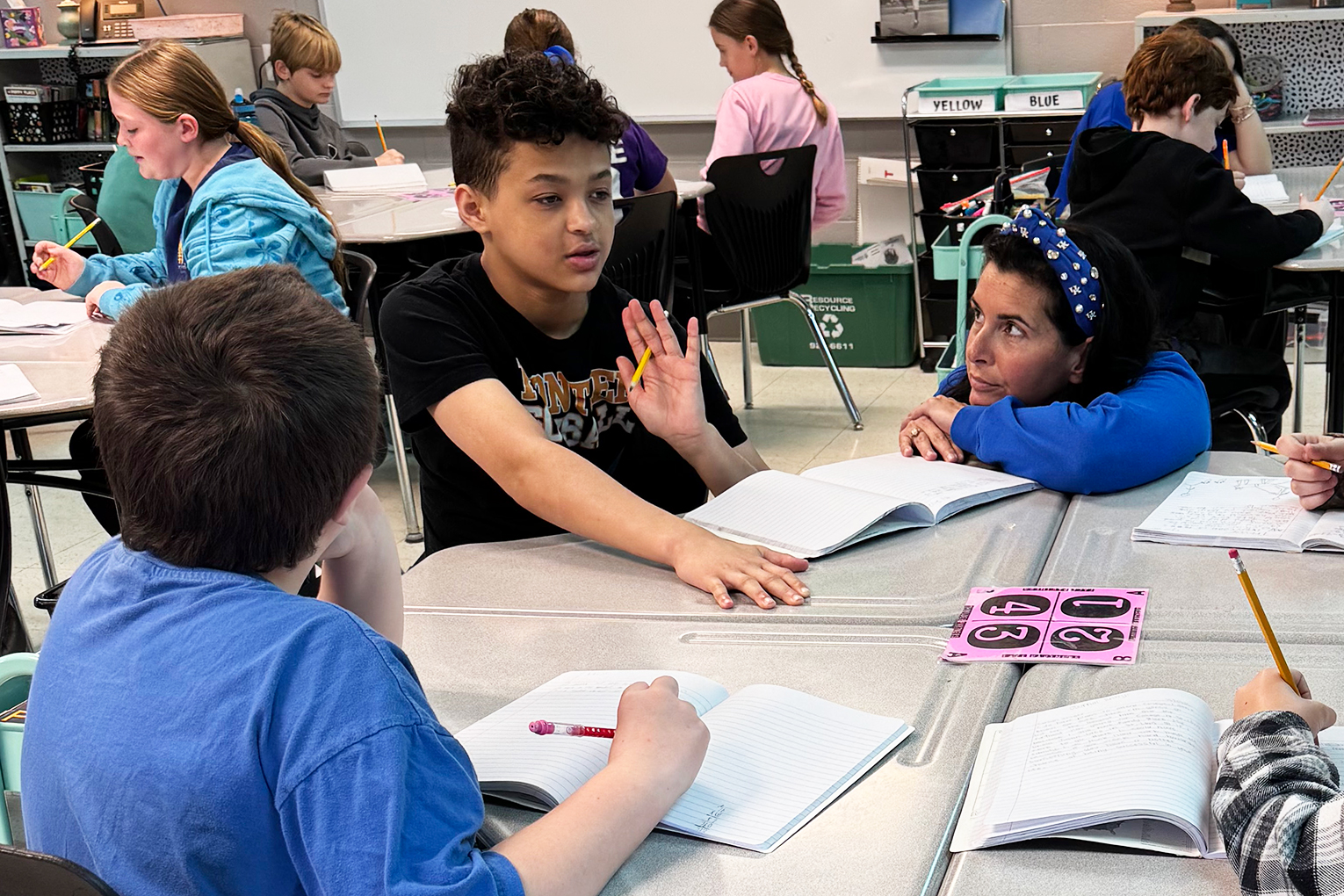
Fifth-grade teacher Amy Jervis (left) and Susan Elza, (right) GEAR UP academic specialist, explain the student engagement strategies they use at East Bernstadt Elementary (East Bernstadt Independent) during the 2015 AdvancED Continuous Improvement Summit in Lexington.
Photo by Brenna Kelly, Sept. 22, 2015
By Brenna R. Kelly
Brenna.kelly@education.ky.gov
Keeping students interested, invested and excited as the school year drags on can be tough. But Amy Jervis and Susan Elza, teachers at East Bernstadt Elementary, were determined that it didn’t have to be that way.
“We started working on student engagement, we felt like that would impact the learning that’s taking place in our classrooms,” Elza said.
So Elza, Jervis and the other teachers at the 460-student school in East Bernstadt Independent sought out ways to make their lessons more interesting and at the same time, give students a deeper understanding of the content.
They collected strategies that use technology, gamification, group activities and sometimes silence to keep students active as they are learning.
Jervis and Elza presented their techniques to a standing room only crowd of educators at September’s 2015 AdvancED Continuous Improvement Summit in Lexington. The pair were asked to present after a team from AdvancED visited their school as part of GEAR UP, a federally funded program designed to make sure all the students in a 7-year cohort are college and career ready.
Elza, who taught 4th- and 5th-grade reading until last year, is now the school’s GEAR UP academic specialist.
“The feedback that AdvancEd gave us was really positive and they felt like we had a lot of engagement going on in our classes,” Elza said.
Since that evaluation, teachers at East Bernstadt have discovered a tool that turns their classrooms into a game show. Kahoot has become one of Jervis and Elza’s favorite tools.
Teachers use the free website to create quizzes in which students can see the responses in real time. Teachers can build their own games or use games other teachers already have made. Students use any Internet-connected device to answer multiple choice questions and the results are shown on a large screen similar to a leader board.
“Kahoot is our teacher’s favorite tool for student engagement,” Elza said, noting that even the art and music teacher uses it to teach a Classical music unit.
It can be used as a pre-test to gauge students’ knowledge of a topic or close to the end of a lesson to help teachers see if there’s something students don’t understand.
“You can use it to spice up that boring topic,” Elza said. “It’s something you can use for any subject in any form or fashion.”
Classes also can play with other classes in their school, district or around the world. According to its website, Kahoot is used in more than 180 countries.
Another strategy the pair highlighted uses something most student already like to do, talk to their classmates. Jervis likes to use the partner/coach strategy with her 5th-grade mathematics classes. While one student works on solving a math problem, the other student guides them through the steps, Elza said. Then the students switch roles.
“When they talk about the problem together it leads to deeper understanding,” Elza said.
Learning from classmates is also one of the goals of the table top strategy, in which four students sit at a table. Each student has a shoulder partner and a face partner. A large sheet of paper covers the table, divide into four work spaces with a large work space in the middle.
First students work independently on a math problem, using their work space to show their work.
“They’re not talking, they’re not bothering each other, they are just doing it on their own,” Jervis said.
Students discuss the problem and their answer with their shoulder partner and then with their face partner. When students explain their work to their partners, Elza said, they can learn from the partner and see where they went wrong.
Afterward, students discuss all of the answers and decide which student had the best answer. They put that answer in the middle of the sheet of paper and present their decision to the class.
“I do this a lot with problem solving,” Jervis said. “Problem solving is something that they struggle with, so this makes it a little bit more fun.”
Another group exercise lets students collaborate, but also allows for individual accountability. Elza took a method called group constructed response that she learned at a professional development training and tweaked into something new. In constructed response, students use the RACE format — restate, answer, cite textual evidence and explain — to answer a question.
In Elza’s exercise, students are grouped and then each student in the group is assigned one of the RACE steps and a colored marker. The groups have a set amount of time to write out the answer on a large poster board.
“Each child has a writing role, but it takes a group effort to get that answer totally constructed in the form that you’re after,” Elza said.
Because answers are in different-colored markers, the teacher knows which student was responsible for which answer even though it’s a group activity.
“You might have some that can write beautifully, you might have others who can answer it orally, but have trouble getting it on paper. This allows everyone to share their answers and ideas,” Elza said.
When time runs out, the groups post their posters around the classroom and students score the responses using sticky notes.
“Then you can have a class discussion about why they scored it that way,” Elza said.
The teaching method that immediately catches students’ attention requires the teacher to remain silent the entire class. Several East Bernstadt teachers attended a professional development seminar last year and brought back method called silent teaching, in which the teacher uses only visual cues to instruct students.
“Students see the activity as a game,” Elza said. “They love it.”
While the teacher writes a math problem on the white board, he or she has the students’ full attention because with a nod or a finger point, the student might be called upon to demonstrate the skill being taught on the white board.
“They get nervous because they don’t know who the teacher is going to pick,” Elza said. “It makes them accountable for learning and listening – all the things that we want them to do on a daily basis.”
Jervis uses the method to teach the order of operations in mathematics. While it might sound odd, she said, it works. Because the teacher isn’t explaining everything, students have to use their problem solving skills to think it through, she said.
“This is one of those things you have to do it and experience it to really see the impact that it can have on the students,” Jervis said. “They are totally engaged, their eyes are totally on me, more so than if I was up there talking.”
MORE INFO….
Susan Elza susan.elza@ebernstadt.kyschools.us
Amy Jervis amy.jervis@edbernstadt.kyschools.us
PDF from the Continuous Improvement Summit presentation




Leave A Comment